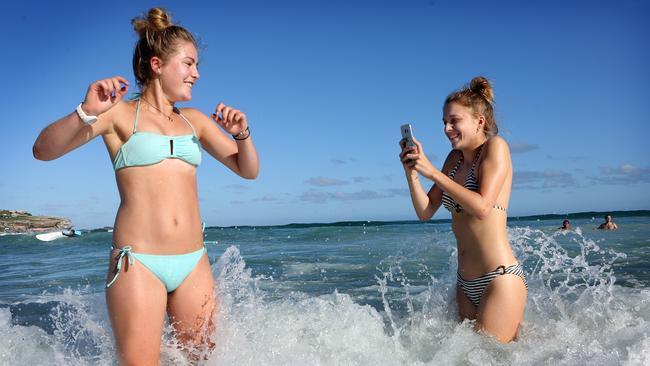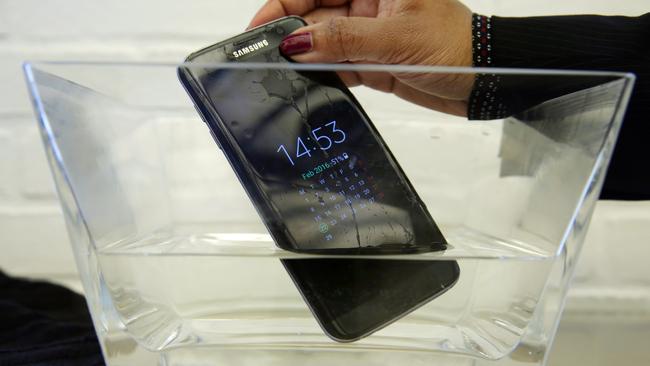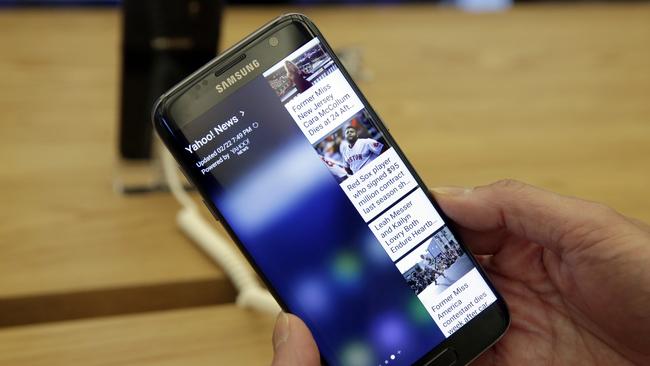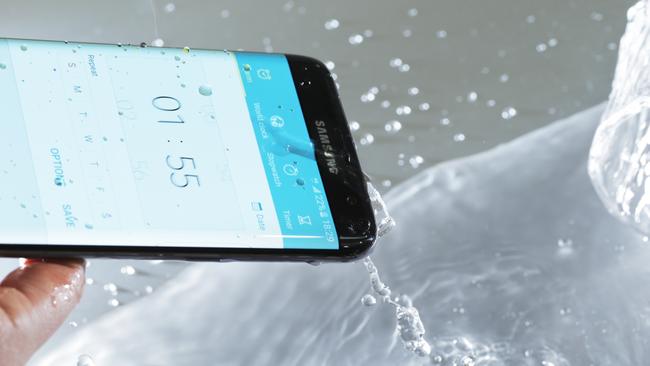Samsung Galaxy S7 edge review: phone at home in the foam
Splashing around in the ocean with a shiny new Samsung could evoke looks of horror — but times are changing | REVIEW

Splashing around in the ocean with a shiny new Samsung could evoke looks of horror. After all, who in their right mind would risk an $1100 smartphone by trying to take snaps underwater?
But times are changing. Water resistance is one of the features of Samsung’s latest challenge to the iPhone: the 5.1-inch Galaxy S7 and the larger 5.5-inch Galaxy S7 edge, which go on sale in Australia on Friday.
Phones can now be fun to play with in the ocean, as British tourists Amelia Vegting and Kirsty Maxwell discovered yesterday in the surf at Sydney’s Bondi. “We think it would be cool to be able to do this, we could get good pictures travelling with this,” Ms Maxwell said.
This year the Korean electronics giant needs a killer phone as it’s fighting on multiple fronts, trying to snare market share from Apple while wooing afresh users disgruntled with what the S6 took away. And there’s an emerging fleet of quality phones from China costing half the price.
Samsung has reversed decisions made with the S6 to dump water resistance and not support add-on storage using a microSD card. The reversal is Samsung’s mea culpa and early indications are the S7 is enjoy some success. Samsung last week claimed record presales of the S7.

In Australia the lower dollar means you’ll pay handsomely when the S7s sell from Friday. The S7 edge will sell outright for $1,249 and the S7 $1,149. Until now, Samsung sought to soften the blow by offering those who preordered the phone a free Gear VR headset. It meant users could experience virtual reality, currently the hottest consumer technology on the planet.
I’ve been testing the premium model, Galaxy S7 edge, whose display has curved glass edges. It’s a conservative departure from last year’s S6 edge models. They had 5.1-inch and 5.7-inch screens; the S7 edge comes in between at 5.5 inches.
Conservatism also prevails with Samsung’s decision not to introduce a USB Type-C port found on newer Android device. Instead it’s sticking with the safety of the familiar and trusted microUSB connector.
Physically the S7 edge is a beautiful phone. Curved edges on the sides front-end-back accentuate its slim design, and the silver coloured top panel and chin on my test unit engender elegance. Adding to this is a bright and vivid quadHD AMOLED display. Watching 2K and 4K video on that display is a treat. But the glass back of the phone is a fingerprint magnet. You might prefer a handset with a more textured grip.
Globally S7 units are selling with 32GB and 64GB of internal storage, but in Australia there’s only 32GB models, officially at least. That 32GB is precious as 8GB, a quarter of it, is taken up with the operating system. So you’ll likely to need that extra microSD card storage. Samsung says the phone handles up to 200GB of additional storage. A single cradle at the top holds the SIM card and microSD card.

Google’s Android Marshmallow operating system allows for microSD card storage to be used in two ways: as separate portable storage that you can swap in and out, and now, as a seamless extension of internal storage. I discovered only the first mode works with the S7 edge. It may not seem an important distinction, but the new mode gets around having to decide which storage to use for what purpose, and having to shuffle files between them.
An IP68 rating means the phone is certified as dust proof and water resistant to 1.5 metres for 30 minutes. So you can comfortably take the S7 models to the beach, as our tourists did at Bondi. But if you use the phone to take snaps underwater, remember that the touch sensitive screen will be unresponsive. I could take snaps in my pool using the volume down key as the shutter button.
For video, you have to set the camera rolling on the surface first. But you don’t have control over focus and I found getting sharp photos is hit and miss. You should always rinse the phone is clean water afterwards.
When I took the phone out of water, I encountered a “moisture has been detected” message. There’s a sensor in the phone that prevents it charging if it detects moisture. It’s a safeguard but a curse too. As a result, the phone wouldn’t charge for about 10 minutes. After that, all was OK. But I wondered if Samsung should again include seals to stop moisture being a problem in the first place.
Out of the water the back-facing camera is a pleasure to use. The main snapper is 12 megapixels instead of 16 megapixels with the S6. But it handles lower light conditions well. It’s a speciality of this phone with a dual pixel sensor offering high-performance focus tracking. It’s normally a DSLR feature. You can also shoot hyperlapse video: time-compressed video that moves smoothly with the camera.
Cheekily, Samsung has included a small USB connector in the box. It lets you connect another Android phone or an iPhone directly to an S7 and transfer content between them. The idea is that you easily port data from a phone you are ditching to the S7.

But I have doubts about the usefulness of this “smart switch” feature as it can take up to 15 minutes to read the files on your old device. In that time I could have whipped them out to a PC using a conventional cable connection and copied them into the new phone.
Despite several tries, I couldn’t get it to transfer music in from an iPhone 6s plus. The software froze while it was reading the iPhone. But I could use the connector to transfer data from a USB hub and from several USB flash drives. Apps such as ES File Explorer make this process easier to achieve. That’s really useful.
There is some confusion globally as to the phone’s performance compared to iPhone 6s because it comes with two different processors: one in US handsets and another in the rest. According to test results published by AnTuTu, which measures mobile device performance, the Qualcomm 820 processor in S7 US handsets beats Apple’s A9 processor found in iPhone 6s/6s Plus. But the Exynos 8890 processor in Australian models (including my test unit) isn’t as powerful and comes in under the A9.
I verified this with my handset which scored 115,870 in AnTuTu’s test overall. The difference is even bigger when it comes to graphics performance. My S7 edge recorded a score of 36,773 in 3D graphics performance, well behind the Qualcomm 820 benchmark.
Samsung also has listened to concerns about battery life with the S6 range. As a result, the S7 has a bigger 3,000 milliampere hour battery, the S7 edge a huge 3,600m Ah one. The S6’s battery in comparison was 2550 mAh, the S6 edge’s 2,600 mAh. With a 38 per cent battery capacity boost the S7 edge delivered 15 hours watching video at 75 per cent display brightness. Samsung’s fast charger replenishes the battery quickly. The phone also supports wireless charging.
There’s also some noteworthy new features. “Always on” displays basic details on the home screen when the phone is in sleep mode. Samsung says the phone lights up only the OLED pixels needed for the information, thereby saving power.

By default it shows the date, time, battery level and the number of missed calls and SMS notifications. Nothing else. Alternatively, you can configure “always on” to show the current month’s calendar. But you can’t tap in and see details of your appointments. There’s another option for displaying static images. It’s limited but Samsung says third parties can develop custom implementations.
There’s an edge panel of configurable menu items that I accessed by swiping from the right, and a split screen view which I triggered by long-pressing the recent apps key. It works both vertically and horizontally. I’d love the option to be able to save a configured split view and recall it — Eg if I always liked displaying mail next to my calendar.
There’s also an option to show a night clock on the edge screen. It’s activated through display settings.
The S7 models have NFC and are ready for Samsung Pay due in Australia in coming months.
There’s a game launcher designed to let users manage battery consumption and minimise notifications. Given the problems of heating with the S6, Samsung has introduced “liquid cooling”. It says liquid vaporises near the processor and vapour travels along a small pipeline before condensing again.
By addressing the shortcomings of its predecessor, and not radically changing the phone, Samsung has given itself a great chance to snare Android users away from other choices. But it also faces increased competition from China-branded phones with premium features costing hundreds less and gaining recognition in the market. Nevertheless the S7 edge raises the bar in the Android phone world. There’s no doubt about that.
Price: $1,249 or on contract
Rating: 9/10



